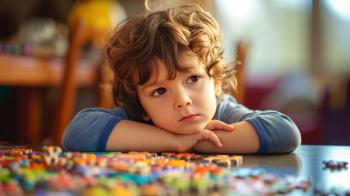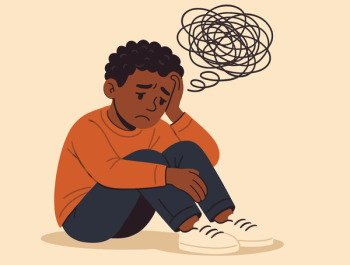
- Vol 37, Issue 9
- Volume 37
- Issue 9
For Whom the School Bell Tolls: Helping Youth During the COVID-19 Crisis
Younger patients are facing unique psychological challenges during this pandemic.
The year 2020 has proven to be a year of challenges and uncertainties thanks to
The reopening debate: in-person versus online learning
One of the most contested issues in the country revolves around the reopening of schools. On the one hand, there are concerns over the social and learning needs of children; on the other are the health risks facing students, teachers, other school personnel, and their respective families.
In July, the
“Reopening schools in a way that maximizes safety, learning, and the well-being of children, teachers, and staff will clearly require substantial new investments in our schools and campuses. We call on Congress and the administration to provide the federal resources needed to ensure that inadequate funding does not stand in the way of safely educating and caring for children in our schools. Withholding funding from schools that do not open in person full-time would be a misguided approach, putting already financially strapped schools in an impossible position that would threaten the health of students and teachers.”
The
What is “safe”? Lessons from around the world
The push to open schools in-person was originally based on the theory that children were largely not affected by COVID-19 and that transmission from asymptomatic children was uncommon. However, this assumption came after the strict physical distancing measures and school closures, and the story appears to have changed. The appearance of multisystem inflammatory syndrome, which causes serious, even life-threatening illness in previously healthy children and adolescents, served as a rude wake-up call.3 By August 6, 2020, the Centers for Disease Control received reports of 570 cases and 10 deaths across 40 jurisdictions (
New data also show that children are not invulnerable to COVID-19. In the United States, the number of cases in children rose 44% between July 9 and July 23, according to a report which also found that children accounted for 8.4% of US cases.5 With 20 states reporting, researchers found between 0.6% and 9.0% of all juvenile COVID-19 cases resulted in hospitalization, confirming that severe illness was possible in children, albeit rarer than in adults. Similarly, in 8 days in July, Florida saw a 34% increase in new cases and a 23% increase in hospitalizations among children; the test positivity rate among children also increased.6 Recent news reports also tell of thousands of students and teachers quarantined as the number of COVID-19 infections rip through schools in several states after re-opening in person.7
Some proponents of a wider in-person school opening have noted that children are less likely to spread the virus, but a new report in JAMA Pediatrics contradicts this notion.8 The authors found that replication of SARS-CoV-2 in older children resulted in similar levels of viral nucleic acid as in adults, but found significantly greater amounts of viral nucleic acid in children younger than 5 years. Considering behavior and hygiene issues in younger children, the authors said, “Young children can potentially be important drivers of SARS-CoV-2 spread in the general population.”
Lessons can also be learned by looking abroad. Two weeks after reopening schools, Israel saw a spike in COVID-19 cases, with more than 200 cases among students, and 130 cases at a single school.9 Countries including Singapore and South Korea also experienced spikes in cases when schools were reopened.
Guiding parents and supporting young patients
This is new territory for everyone, and young patients and their parents are likely to experience stress and anxiety as the school year begins. There are several ways parents can prepare themselves and their children for a relatively smooth transition.
First and foremost, clinicians should counsel parents to consider their individual family needs and issues, then develop a clear plan in terms of social distancing.10 Families with at-risk individuals may prefer more stringent rules, while others may err on the side of socialization. Once parents have determined what works best for their family, they should make the socialization rules very clear to their children, discussing realistic and practical strategies to mitigate the chances of infection.11 The approach and discussion should be tailored to the age and maturity of the child.
Children need a sense of safety and stability, so navigating these waters can be tricky. Parents should explain that although schools are reopening, socialization will be a step-by-step process. Regroup as needed with children and adolescents to provide updates, share reminders, and allow for questions.
Children in upper elementary and middle school grades are prone to receiving misinformation, either via friends or social media. Parents should facilitate family conversations, listening carefully to their children’s concerns and helping them separate fact from fiction.
Finally, role play may assist children and adolescents as they negotiate this new school year. It can be difficult even for adults to request that someone maintain their distance or ensure that their mask is properly covering their mouth and nose. Share ways to make the conversations easier. For younger children, you can even make it a game. Act out correct and incorrect behaviors, and see if they can pick out the mistakes.
Special issues associated with psychiatric disorders
Children and adolescents with pre-existing psychiatric disorders may have additional struggles with social distancing, online learning, and the resulting changes and lack of consistency. Although in-person learning is ideal, not all schools will be able to do so. Similarly, even those schools that initially begin in-person learning may need to move to remote learning. Fortunately, there are strategies to help support students with various psychiatric symptoms and disorders.
Children with an attention-deficit/hyperactivity disorder (ADHD) diagnosis. Family confinement and physical distancing may exacerbate ADHD-related risk-taking behavior.12 As much as feasible, additional medication doses should not be used to manage stress related to confinement. Also, steer clear of using any antipsychotic medication to manage disruptive behavior. Instead, use behavioral parenting strategies that have a beneficial effect for children with ADHD and disruptive behavior (
Children with schizophrenia. Treatment adherence may become an issue for these patients. Unfortunately, current evidence does not support the use of outpatient telepsychiatry to improve adherence. For
Children with anxiety disorders. It is quite likely that socially anxious children will refuse to return to school; even under ideal conditions, a new academic year can be a trigger. It is important to validate their feelings and answer questions truthfully, while not offering unnecessary details. Always try to remain calm during these discussions. Whenever possible, parents should avoid excessive reassurance and instead encourage self-reliance. Parents should model how to manage difficult emotions.
It is also important to frame statements in a positive way. For example, avoid phrases like, “There’s nothing to be afraid of,” “It’s not a big deal,” or “You’ll be just fine.” Instead, try, “I would really like for you to go on a bike ride around the neighborhood. The streets are safe.” Additional tips can be found online at the
Since the world has become a scarier place with so many risks outside of the home, it is important that parents inform their child with anxiety every time they leave the house for work or essential errands. It is also helpful to remind them that frontline workers are addressing the situation.
Children with mood disorders. It is important that parents are fully aware of warning signs and symptoms (
It also is important to teach child- ren to recognize their health risk behaviors, such as isolating, excessive sleeping, or lethargy. Encourage them to check in with family or friends. Acknowledge and normalize their distress reactions. For example, parents can share, “I can see that you are very stressed, which is very understandable. Many people are feeling that way.” Other coping strategies are listed in
Children with eating disorders (EDs). The pandemic is causing specific challenges for children with concerns around eating or body image. Disruption in important daily routines such as grocery shopping and exercise can lead to increased anxiety and worsen unhealthy food-related behaviors. These children should remain connected with their therapists, dietitians, and clinicians to create a relapse prevention plan.
I encourage parents to maintain a structure and schedule around the child’s meals and snacks. Families can get creative and encourage a variety of physical activities. The National Eating Disorders Association has extensive offerings of virtual support groups and live meal support.
COVID’s psychological impact
There is much debate and uncertainty regarding how children and adolescents are impacted by the virus. Current research and data from previous epidemics suggest that the pandemic may be directly or indirectly associated with the onset or exacerbation of psychiatric symptoms such as anxiety disorders, depressive disorders, insomnia, and posttraumatic stress disorder.14,15 For instance, a study conducted in the United Kingdom by
Research also indicates that the pandemic may influence psychological issues associated with EDs. A study conducted recently in Australia found increased restricting, binge eating, purging, and exercise behaviors in patients with eating disorders.17 Similarly, increased restrictive and binge-eating behaviors were found in those without EDs. More than 50% of participants with EDs also demonstrated moderate to extremely severe levels of depression, anxiety, and stress.
Clinicians also need to be aware of a rapidly increasing subset of issues that include substance abuse and domestic violence and child abuse, which have become more prevalent during stay-at-home orders.14,18 Clinicians should pay special attention to signs of domestic violence or child abuse, including monitoring for parental stress and irritability or harsh and critical responses to child behavior during clinical encounters. Children who live in foster care, as well as gender or sexual minorities, are at a particular risk for violence and adverse mental health effects; extra care should be taken to screen these patients.15
Clinicians should be familiar with the psychiatric adverse effects associated with the medications used to treat COVID-19. For example, the corticosteroid dexamethasone has benefited some critically ill patients due to its anti-inflammatory and immunosuppressant effects, but its known adverse effects include emotional lability, insomnia, and sudden mood changes.
Telepsychiatry options can be useful to minimize virus exposure. Even when children are reluctant to try online therapy or if parents view it as an inferior option, clinicians should suggest they try it anyway. Many study results, encouragingly, indicate that outpatients and their psychiatrists are generally satisfied with telemedicine.18
An extensive review of 24 studies indicated that the negative effects of quarantine can be lessened when clinicians explain its purpose and how to implement it and when they emphasize the altruistic benefit of quarantine in keeping others safe.20 Depending on age and maturity level, clinicians should consider engaging children and adolescents in such discussions.
Parents also should emphasize that social distancing does not mean emotional distancing. They can offer more hugs and loving and supportive messages.21 Children should be encouraged to stay in touch with their grandparents and extended family via video. Depending on their age, children can connect with peers on social platforms and may also have supervised socially distant playdates. For anxious children, the practice of mindfulness should be considered.20 Clinicians should provide parents with additional general coping strategies (
Concluding thoughts
COVID-19 has presented unusual circumstances and challenges, including the need to balance the physical, emotional, and mental well-being of children and their family members. While there is no perfect one-size-fits-all approach to school reopening and social distancing, clinicians should be prepared to support their younger patients and parents as we all navigate through these choppy waters.
Dr Ramanujam is a practicing child and adolescent psychiatrist in Sacramento, California, and the Regional Medical Director of
References
1. Pediatricians, educators and superintendents urge a safe return to school this fall. American Academy of Pediatrics. News release. July 10, 2020. Accessed July 28, 2020.
2. American Academy of Child and Adolescent Psychiatry (AACAP) and American Psychiatric Association (APA) detail steps necessary for safely reopening schools this fall. American Academy of Child and Adolescent Psychiatry. News release. July 15, 2020. Accessed July 28, 2020.
3. Feldstein LR, Rose EB, Horwitz SM; Overcoming COVID-19 Investigators and the CDC COVID-19 Response Team. Multisystem inflammatory syndrome in U.S. children and adolescents. N Engl J Med. 2020;383(4):334-346.
4. Health department–reported cases of multisystem inflammatory syndrome in children (MIS-C) in the United States. CDC. July 15, 2020. Updated August 6, 2020. Accessed July 31, 2020.
5. Children and COVID-19: state-level data report. American Academy of Pediatrics. July 27, 2020. Updated July 30, 2020. Accessed August 10, 2020.
6. Flores R, Weisfeldt S, Yan H. Child hospitalizations from Covid-19 surge 23% in Florida as schools statewide must reopen. CNN. Updated July 27, 2020. Accessed July 31, 2020.
7. Walker C, Grayer A, Stuart E. More than 2000 students, teachers and staff quarantined in several schools. CNN August 17, 2020. Accessed August 19, 2020.
8. Heald-Sargent T, Muller WJ, Zheng X. Age-related differences in nasopharyngeal severe acute respiratory syndrome coronavirus 2 (SARS-CoV-2) levels in patients with mild to moderate coronavirus disease 2019 (COVID-19). JAMA Pediatr. Published online July 30, 2020.
9. Estrin D. After reopening schools, Israel orders them to shut if COVID-19 cases are discovered. NPR. June 3, 2020. Accessed July 31, 2020.
10. Miller G. Managing anxiety during reopening. Child Mind Institute. 2020. Accessed July 31, 2020.
11. Sharfstein JM, Morphew CC.The urgency and challenge of opening K-12 schools in the fall of 2020. JAMA. Published online June 1, 2020.
12. Cortese S, Asherson P, Sonuga-Barke E, et al; European ADHD Guidelines Group. ADHD management during the COVID-19 pandemic: guidance from the European ADHD Guidelines Group. Lancet Child Adolesc Health. 2020;4(6):412-414.
13. Kozloff N, Mulsant BH, Stergiopoulos V, Voineskos AN. The COVID-19 global pandemic: implications for people with schizophrenia and related disorders. Schizophr Bull. 2020;46(4):752-757.
14. Silliman Cohen RI, Adlin Bosk E. Vulnerable youth and the COVID-19 pandemic. Pediatrics. 2020;146(1):e20201306.
15. Wang G, Zhang Y, Zhao J, et al. Mitigate the effects of home confinement on children during the COVID-19 outbreak. Lancet. 2020;395(10228):945-947.
16. Coronavirus: impact on young people with mental health needs. YoungMinds. 2020. Accessed July 31, 2020.
17. Phillipou A, Meyer D, Neill E, et al. Eating and exercise behaviors in eating disorders and the general population during the COVID-19 pandemic in Australia: initial results from the COLLATE project. Int J Eat Disord. 2020;53(7):1158-1165.
18. Cohen GH, Tamrakar S, Lowe S, et al. Comparison of simulated treatment and cost-effectiveness of a stepped care case-finding intervention vs usual care for posttraumatic stress disorder after a natural disaster. JAMA Psychiatry. 2017;74(12):1251-1258.
19. Wilkinson E. How mental health services are adapting to provide care in the pandemic. BMJ. 2020;369:m2106.
20. Brooks SK, Webster RK, Smith LE, et al. The psychological impact of quarantine and how to reduce it: rapid review of the evidence. Lancet. 2020;395(10227):912-920.
21. Ehmke R. Anxiety and coping with the coronavirus. Child Mind Institute. 2020. Accessed August 2, 2020.
22. Glassy D, Tandon P. Getting children and teens outside while social distancing for COVID-19. HealthyChildren.org (American Academy of Pediatrics). June 18, 2020. Accessed August 2, 2020.
Articles in this issue
about 5 years ago
Bad Men Do What Good Men Dreamabout 5 years ago
The Right Way to Avoid Malpractice Lawsuitsabout 5 years ago
Tips for Testifying in Courtabout 5 years ago
Exploring the Relationship Between Cannabidiol and Psychosisabout 5 years ago
Psychiatry’s Intellectual Crisis: Giovanni Fava, MDabout 5 years ago
Sheltered in Placeabout 5 years ago
Surviving Coronavirus: A Psychiatrist’s Personal Journeyabout 5 years ago
A Dose of Much-Needed MedicineNewsletter
Receive trusted psychiatric news, expert analysis, and clinical insights — subscribe today to support your practice and your patients.














